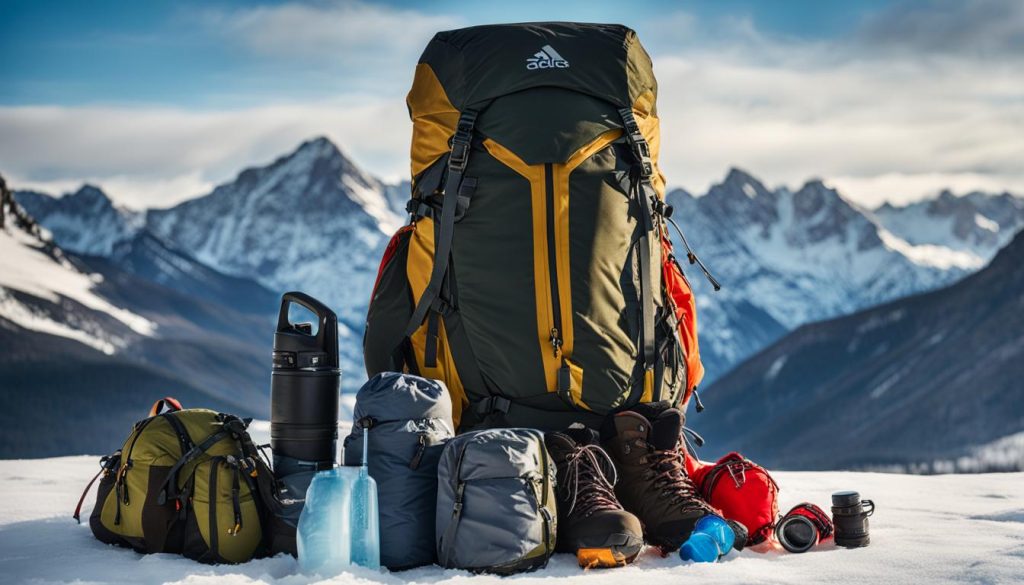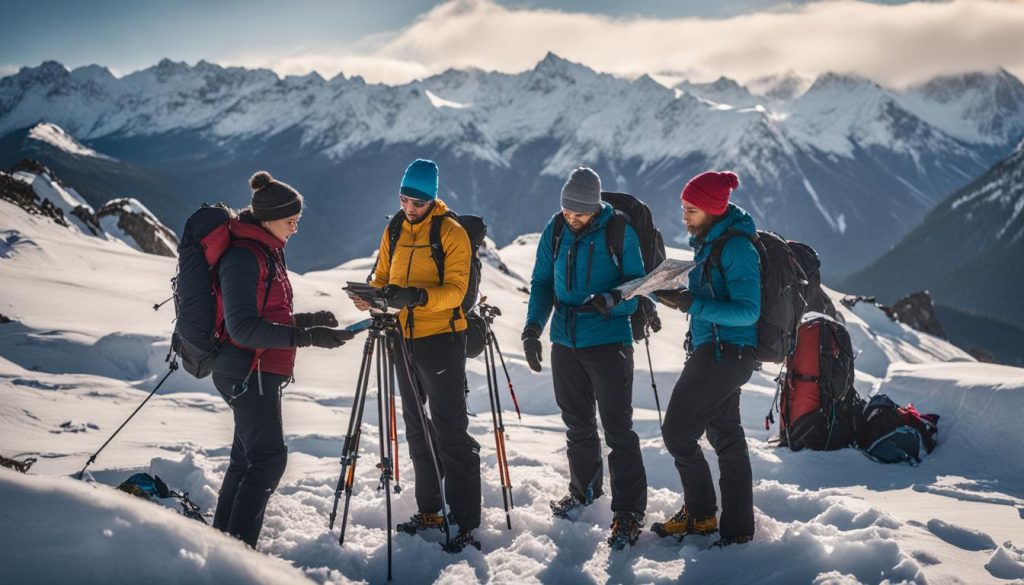Winter hiking can be a breathtaking experience, with snow-covered trails and stunning vistas. However, it’s important to prioritize safety when venturing out into the cold. Whether you’re an experienced hiker or new to the sport, following these winter hiking safety tips will ensure you have a safe and enjoyable outdoor adventure!
Key Takeaways:
- Dress in layers and wear moisture-wicking fabrics to regulate body temperature and stay comfortable.
- Start with shorter and easier trails to acclimate to winter hiking conditions.
- Bring essential safety gear, such as a trail map, first aid kit, compass, and headlamp.
- Check the weather forecast and avoid hiking in unfavorable conditions.
- Hike with a friend or in a group for increased safety and enjoyment.
Dressing for Winter Hiking: Layering and Essential Gear
When it comes to winter hiking, dressing appropriately is key to staying comfortable and safe on the trails. Layering your clothing allows you to regulate your body temperature as the weather changes during your hike. Start with a moisture-wicking base layer to keep sweat away from your skin, then add insulating mid-layers such as long underwear, a light fleece or softshell jacket, and waterproof pants. Carrying an insulated jacket, fleece pants, and a waterproof shell jacket in your backpack ensures you’re prepared for any foul weather conditions.
Don’t forget to pay attention to your extremities. Keep your feet warm and dry by investing in thick, winter-weight socks and waterproof boots. Layering your hands with two pairs of gloves or mittens provides insulation and waterproofing. And, of course, don’t forget to wear a beanie to keep your head warm.
When it comes to essential gear, there are a few items you should never hike without. A first aid kit, compass, pocket knife or multi-tool, hand warming packets, and a headlamp are all crucial for your safety during a winter hike. If you’re hiking with a group, consider distributing some of the heavier safety items among your group members to lighten your load.
To give you a better idea of the gear you should consider for winter hiking, here’s a comparison table of some recommended items:
| Item | Recommended Brand |
|---|---|
| Insulated Jacket | Patagonia Nano Puffy Jacket (Women’s) or Patagonia Down Sweater (Men’s) |
| Hiking Socks | REI Merino Wool Expedition |
| Gloves | Patagonia Better Sweater Gloves |
Remember, investing in good-quality gear will ensure your comfort and safety during your winter hikes. Look for end-of-season sales and discounts to save money on essential items. Now that you know how to dress for winter hiking, you’re ready to hit the trails and enjoy the beauty of the winter landscapes!

References:
- Patagonia. (n.d.). Retrieved from https://www.patagonia.com
- REI Co-op. (n.d.). Retrieved from https://www.rei.com
Planning and Safety Precautions for Winter Hiking
When it comes to winter hiking, proper planning and safety precautions are crucial to ensure a safe and enjoyable experience on the trails. To help you prepare for your winter adventures, here are some essential tips to keep in mind.
Start small and start early
Beginners should start with shorter and easier trails when planning their first winter hike. Consider the distance, difficulty, and accessibility of the trail, as well as the potential for ice and snow. It’s also important to start early in the day to maximize daylight hours and allow for any unexpected delays.
| Trail Info Apps | Features |
|---|---|
| Gaia GPS | – Detailed trail information – Length, altitude gain, and reviews – Access to recent hikers’ photos |
Inform someone about your plans
Before heading out, make sure to inform a trusted friend or family member about your hiking plans. Provide them with details of the trail you’ll be taking and your estimated return time. This way, someone will be aware of your whereabouts and can alert authorities if you don’t return as scheduled.
Be prepared with the right gear
Carrying the necessary safety gear is essential for winter hiking. Make sure to pack a first aid kit, compass, pocket knife or multi-tool, hand warming packets, and a headlamp. Distribute some of the heavier items among your group members if hiking in a group. Don’t forget to check the weather forecast and dress appropriately with waterproof clothing, insulated jackets, and proper footwear.
By following these planning and safety precautions, you’ll be well-prepared for your winter hiking adventures. Remember, always prioritize safety, stay informed about the trail conditions, and enjoy the beauty of winter landscapes responsibly.

Conclusion
Winter hiking can be a magical experience, but it’s important to prioritize your safety. By following these winter hiking safety tips, you can enjoy the beauty of winter landscapes while staying safe and comfortable on the trails.
First, dress in layers and wear appropriate winter hiking gear to regulate your body temperature and stay warm. Invest in quality gear like waterproof clothing, insulated jackets, and winter-weight socks.
Next, plan your hikes carefully. Start with shorter and easier trails, check the weather forecast, and be prepared to turn around if conditions become dangerous. Inform someone about your hiking plans and carry essential safety items like a first aid kit, compass, and headlamp.
Hiking with a friend or in a group adds an extra layer of safety and enjoyment. Stay hydrated, fuel your body with the right snacks, and reward yourself with a satisfying meal after completing a winter hike.
Remember, staying safe in winter hikes is crucial. Take the necessary precautions, be mindful of the conditions, and make smart decisions along the way. Stay warm and have a fantastic winter hiking experience!
FAQ
How should I dress for winter hiking?
Dress in layers and wear moisture-wicking fabrics. Start with a base layer, add mid-layers for insulation, and carry an insulated jacket and waterproof shell jacket in your backpack.
What gear do I need for winter hiking?
Essential gear includes a trail map, first aid kit, compass, pocket knife or multi-tool, hand warming packets, and a headlamp. Consider investing in crampons or snowshoes, waterproof clothing, gaiters, insulated jackets, and hiking poles.
How should I plan and prepare for winter hiking?
Start with shorter and easier trails, check the weather forecast, inform someone about your plans, and download trail info apps. Be knowledgeable about winter-specific challenges and bring extra food and emergency gear.
What safety precautions should I take while winter hiking?
Hike with a friend or in a group, learn how to use microspikes, and stay hydrated. Be prepared to turn around if conditions become dangerous and postpone your hike if the weather forecast is unfavorable.


